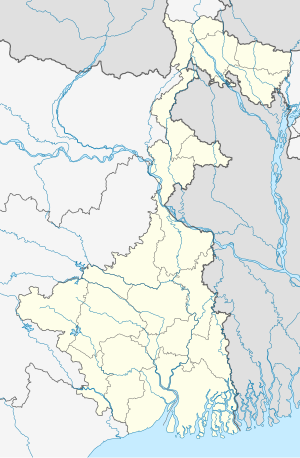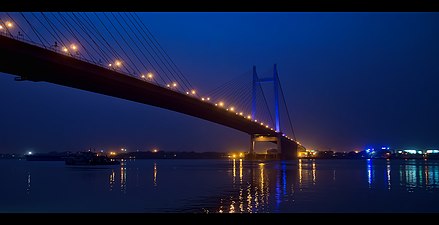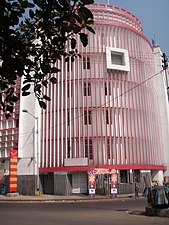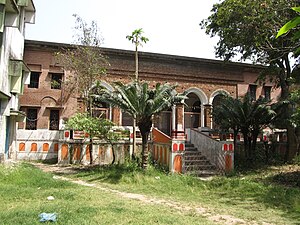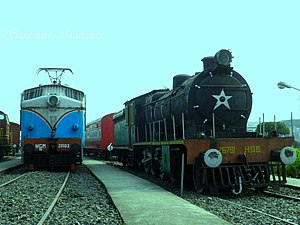Howrah
Howrah | |
|---|---|
The Howrah Bridge Howrah Junction railway station, biggest (in terms of number of platforms), oldest and busiest railway station of India Inside IIEST Shibpur campus High-rise apartments in Santragachi | |
| Nickname: | |
| Coordinates: 22°34′48″N 88°19′46″E / 22.58000°N 88.32944°E | |
| Country | |
| State | |
| Division | Presidency |
| District | Howrah |
| Government | |
| • Type | Municipal Corporation |
| • Body | Howrah Municipal Corporation |
| • Police commissioner | C Sudhakar, IPS[4] |
| Area | |
| 63.55 km2 (24.54 sq mi) | |
| • Metro | 450.65 km2 (174.00 sq mi) |
| Elevation | 12 m (39 ft) |
| Population | |
| 1,077,075 | |
| • Density | 17,000/km2 (44,000/sq mi) |
| • Metro | 2,811,344 |
| Languages | |
| • Official | Bengali[10][11] |
| • Additional official | English[11] |
| Time zone | UTC+5:30 (IST) |
| PIN | 711101 to 711114, 711201 to 711204 and 711302 and 711409 |
| Telephone code | +91 33 |
| Vehicle registration | WB-11 to WB-14 |
| Lok Sabha constituency | Howrah |
| Vidhan Sabha constituency | Howrah Uttar, Bally, Howrah Madhya, Howrah Dakshin, Shibpur |
| Website | www |
Howrah (/ˈhaʊrə/; Bengali: [ˈɦao̯ɽa]; alternatively spelled as Haora)[12] is a city[13][3] in the Indian state of West Bengal. Howrah is located on the western bank of the Hooghly River, opposite its twin city of Kolkata.[3] Administratively Howrah lies within Howrah district and is the headquarters of the Howrah Sadar subdivision; it is also part of the area covered by Kolkata Metropolitan Development Authority (KMDA). Howrah is an important industrial and transportation hub, and is also a gateway to Kolkata (and the rest of West Bengal) via Howrah railway station and Howrah Bridge.
Etymology
[edit]The name came from the word Haor—Bengali word for a fluvial swampy lake, which is sedimentologically a depression where water, mud and organic debris accumulate.[citation needed] The word itself was rather used in eastern part of Bengal (now Bangladesh), as compared to the western part (now West Bengal).[14]
History
[edit]The history of the city of Howrah dates back over 500 years, but the district is situated in an area historically occupied by the ancient Bengali kingdom of Bhurshut. Venetian explorer Cesare Federici, who travelled in India during 1565–79, mentioned a place called Buttor in his journal circa 1578.[15] As per his description, this was a location into which large ships could travel (presumably the Hoogli river) and perhaps a commercial port.[15] This place is identifiable with the modern day neighbourhood of Bator.[15] Bator was also mentioned in the Bengali poetry Manasamangal written by Bipradas Pipilai in 1495.[16]
In 1713, the Bengal Council of the British East India Company, on the accession of the Emperor Farrukhsiyar, grandson of Aurangzeb, to the throne of Delhi, sent a deputation to him with a petition for a settlement of five villages on west bank of Hooghly river along with thirty-three villages on the east bank.[17] The list of villages appeared in the Consultation Book of the Council dated 4 May 1714. The five villages on the west bank on Hooghly river were: 'Salica' (Salkia), 'Harirah' (Howrah), 'Cassundeah' (Kasundia), 'Ramkrishnopoor' (Ramkrishnapur) and 'Battar' (Bator): all identifiable with localities of modern-day Howrah city.[18] The deputation was successful except for these five villages.[18] By 1728, most of the present-day Howrah district was part of either of the two zamindaris: Burdwan or Muhammand Aminpur.[18]
On 11 October 1760, as a result of the Battle of Plassey, the East India Company signed a treaty with Mir Qasim, the Nawab of Bengal, to take over the control of Howrah district.[19] In 1787 the Hooghly district was formed and in 1819 the whole of the present day Howrah district was added to it.[20] The Howrah district was separated from the Hooghly district in 1843.[21]
Demographics
[edit]Howrah is 2nd most populated city in West Bengal (behind Kolkata).[23][24] As of 2011[update] Indian census, Howrah had a population of 1,077,075 with households.[8][note 1][25]
In the 1896 census of British India, Howrah had a population of 84,069, which grew to 157,594 in the 1901 census.[26][27] This rapid growth was due to abundance of job opportunities, which resulted in a 100% increase in male population during this period, whereas the female population grew only by 60%.[26]
| Year | Population | % increase | Males | Females |
|---|---|---|---|---|
| 1896 | 84,069 | |||
| 1901 | 157,594 | 99,904 | 57,690 | |
| 1911 | 179,006 | 13.59 | 114,566 | 64,440 |
| 1921 | 195,301 | 9.10 | 128,472 | 66,829 |
| 1931 | 224,873 | 15.14 | 145,120 | 79,753 |
| 1941 | 379,292 | 68.67 | 246,959 | 132,333 |
| 1951 | 433,630 | 14.33 | 268,412 | 165,218 |
| 1961 | 532,692 | 22.84 | 325,493 | 207,199 |
| 1971 | 737,877 | 38.52 | 439,457 | 298,420 |
| 1981 | 744,429 | 0.89 | 421,636 | 322,793 |
| 1991 | 950,435 | 27.67 | 528,396 | 422,039 |
| 2001 | 1,007,532 | 6.01 | 547,068 | 460,464 |
| 2011[8] | 1,077,075 | 6.90 | 561,220 | 515,855 |
At the time of the 2011 census, 79.48% of the population spoke Bengali, 8.52% Hindi and 9.24% Urdu as their first language.[28]
Geography
[edit]Climate
[edit]Howrah has a Tropical wet-and-dry climate (Köppen climate classification Aw). The summers here have a good deal of rainfall, while the winters have very little. The temperature averages 26.3 °C. Precipitation averages 1744 mm.[29]
Howrah has been ranked 40th best “National Clean Air City” (under Category 1 >10L Population cities) in India.[30]
| Climate data for Howrah, 1981–2010 | |||||||||||||
|---|---|---|---|---|---|---|---|---|---|---|---|---|---|
| Month | Jan | Feb | Mar | Apr | May | Jun | Jul | Aug | Sep | Oct | Nov | Dec | Year |
| Mean daily maximum °C (°F) | 25.8 (78.4) |
29.2 (84.6) |
33.5 (92.3) |
35.3 (95.5) |
35.3 (95.5) |
33.8 (92.8) |
32.4 (90.3) |
32.2 (90.0) |
32.4 (90.3) |
32.2 (90.0) |
30.1 (86.2) |
27.0 (80.6) |
31.6 (88.9) |
| Mean daily minimum °C (°F) | 14.1 (57.4) |
17.8 (64.0) |
22.4 (72.3) |
25.3 (77.5) |
26.4 (79.5) |
26.8 (80.2) |
26.5 (79.7) |
26.4 (79.5) |
26.0 (78.8) |
24.1 (75.4) |
19.7 (67.5) |
15.2 (59.4) |
22.6 (72.7) |
| Average precipitation mm (inches) | 10.4 (0.41) |
20.9 (0.82) |
35.2 (1.39) |
58.9 (2.32) |
133.1 (5.24) |
300.6 (11.83) |
396.0 (15.59) |
344.5 (13.56) |
318.0 (12.52) |
180.5 (7.11) |
35.1 (1.38) |
3.2 (0.13) |
1,836.4 (72.3) |
| Average rainy days | 1.1 | 1.7 | 2.2 | 3.4 | 7.0 | 12.8 | 17.7 | 16.9 | 13.9 | 7.4 | 1.3 | 0.5 | 85.9 |
| Source: India Meteorological Department[31] | |||||||||||||
Civic administration
[edit]Howrah Municipal Corporation is responsible for the administration of Howrah. The tenure of the last board of HMC had ended back on 10 December 2018. From then onwards the corporation has been run by unelected board of administrators selected by the West Bengal government.[32] The Howrah City Police is responsible for law enforcement in the city.
History
[edit]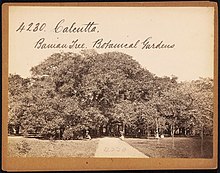
Howrah Municipality was established in 1862.[33] From 1896, it started supplying filter water across the city.[34] During 1882–83, Bally Municipality was formed separating it out from Howrah.[26] As per the Howrah Municipal Corporation Act of 1980, Howrah became a municipal corporation in 1984.[35] The corporation area was divided into fifty wards, each of which elects a councillor.[36] The Mayor-in-council, which is led by Mayor and supported by Commissioner and officers, is responsible for administration of the corporation area.[36] In 2015, the Bally Municipality was re-amalgamated into Howrah Municipal Corporation, through Corporation vide notification no. 428/MA/O/C-4/IM-36/2014 dated 26 June 2015, which increased the total number of wards to 66.[5][37]
Other administrative offices
[edit]Howrah also hosts the temporary administrative office of the state of West Bengal. The office of the Chief Minister of state had been traditionally posted at the Writers' Building, however owing to renovation of the building, the administration has been occupying the Nabanna building.[38]
Development and growth
[edit]Even though it is one of the largest cities in the state, Howrah witnessed urbanization in an unplanned manner.[citation needed] As a result, Howrah is continuing to face its perennial problems like traffic congestion, population explosion and pollution.[39][citation needed]
The city contains a few unlicensed and unregulated residential areas or slums. The name of the novel City of Joy, which has been often the name the Kolkata metropolis been called, is actually based on one such slum of Howrah.[40]
However, recently, work has been done on broadening the National Highways and several local roads.[citation needed] These activities are expected to help in improvement of traffic conditions. Of late, Howrah has seen a lot of new industrial proposals like the Kona Truck Terminus,[41] Kolkata West International City and relocation of the old smoky foundry plants.[citation needed]. The West Bengal Government has also planned a major renovation of the city to match the city's urban facilities with its neighboring city Kolkata.[42]
Kolkata Metropolitan Development Authority (KMDA) is the statutory planning and development authority for Howrah, as the city lies within the Kolkata Metropolitan Area (KMA).
Economy
[edit]Often termed as Sheffield of the East,[43] Howrah is known as an engineering hub, mainly in the area of light engineering industry.[43] In 1823, Bishop Reginald Heber described Howrah as the place "chiefly inhabited by shipbuilders".[44] There are small engineering firms all over Howrah, particularly around Belilios Road area near Howrah station[45] However these businesses are declining in the 21st century.[43] There are many foundries in Liluah area.[citation needed]
Burn Standard Company, a major company in heavy engineering industry, has its oldest manufacturing unit located in Howrah.[46] Ramkrishna Forgings one of the largest forging company in India has one of its plant located at Liluah in Howrah. The Howrah plant of Shalimar Paints (established in 1902) was the first large-scale paint manufacturing plant to be set up not only in India but in entire South East Asia.[47] The city houses one of the major manufacturing units of Tarsons Products.[48] The jute industry suffered during the Partition of Bengal (1947), when the larger jute production area became part of East Pakistan (now Bangladesh). The foundry industry saw a decline in demand due to growth in steel industry.[citation needed]
Transport
[edit]Howrah can be accessed from its many rail links, road links to National Highways, as well as its transport connections to Kolkata. Apart from the bridges connecting the cities, there are also ferry services between various jetties.
Rail
[edit]
Howrah railway station (more commonly referred to as Howrah Station) is the major railway station serving Howrah, Kolkata and the neighbouring districts. It is the second busiest rail station in India, along with being the largest railway station in terms of number of platform. It was established in 1854 when a railway line was constructed connecting the city to the coalfields of Bardhaman. Howrah Station serves as a terminal for two railway zones of India: the Eastern Railway and the South Eastern Railway, and it is connected to most of the major cities of India. From Howrah both Eastern Railway and South Eastern Railway operates connecting various stations of the districts of Howrah, Hooghly, Bardhaman, East Midnapore and West Midnapore. Within Howrah city itself, there are twelve more stations, the most prominents being Santragachi and Shalimar.
Metro rail
[edit]
Howrah is served by the Kolkata Metro Line 2 with Salt Lake in Kolkata via a tunnel under River Hooghly. The Metro line connects Howrah to Esplanade as well which will act as interchange where commuters can change sides to travel on the North-South line. On the Howrah side, the 2 Stations will be at Howrah Station and Howrah Maidan. These stations are open for public. The Metro currently connects Howrah Maidan Station on one side to Esplanade Station on the other. Howrah & Mahakaran stations lying in between.The Esplanade to Sealdah section is still under construction as of 13th September 2024 estimated to be completed by 2025.
Roads
[edit]The total road length in Howrah is approximately 300 km (190 miles).[49] Howrah hosts a branch of the Grand Trunk Road – this was built, starting 1804, by the Public Works Department of the British administration.[50] The road starts at the Acharya Jagadish Chandra Bose Indian Botanic Garden[51] and connects to the main road near Chandannagar.[50] Howrah also connects the metropolitan region to the national highways – NH 16 and NH 19, which are connected to Vidyasagar Setu via the Kona Expressway.
Bridges
[edit]
Howrah and Kolkata are separated by the Hooghly River/Ganges and connected by four bridges across the river. These are the:
- Howrah Bridge, also known as Rabindra Setu
- Vidyasagar Setu, also known as the second Hooghly Bridge
- Vivekananda Setu, also known as Bally Bridge
- Nivedita Setu, also known as Second Bally Bridge
The cantilever style Howrah Bridge and the cable-stayed Vidyasagar Setu are counted among the longest bridges in the world within their types.[52]
Other transport
[edit]There are ferry services available, between various jetties in Howrah and Kolkata, which was introduced in the 1970s.[53] The jetties on Howrah side are at Howrah Station, Ramkrishnapur, Shibpur, Shalimar, Bandhaghat, Belur Math, Bally and Nazirganj. Howrah is also served by Netaji Subhas Chandra Bose International Airport, located in Dumdum, Kolkata. The Airport will soon be connected to Howrah via Metro service which is presently under-construction.
Neighbourhoods
[edit]Howrah has many various neighbourhoods, the most notable being Shibpur, Santragachi, Belur, Salkia, Ramrajatala, Liluah, Howrah Maidan and Bally.[citation needed] Shibpur hosts the Acharya Jagadish Chandra Bose Indian Botanic Garden, containing the Great Banyan tree, Avani Riverside Mall is also located here and the Indian Institute of Engineering Science and Technology, Shibpur.[54] Santragachi has a large railway station as well as the Santragachhi Jheel, a large lake that attracts migratory birds during winter.[citation needed] Belur hosts Belur Math, the headquarters of the Ramakrishna Math and Mission. Ramrajatala hosts a famous Rama Temple.[citation needed].
Near Howrah Station is the slum of Pilkhana which was the basis of the famous book and film "City of Joy".[40] Liluah host some of India's oldest railway factories and is also the educational Hub of Howrah.[citation needed].
Education
[edit]The Indian Institute of Engineering Science and Technology, Shibpur is a public engineering and research institution. It is the fourth oldest engineering institution in India, and is an institute of national importance.[55]
Howrah's schools are either run by the state government or by private institutions. The medium of instruction is Bengali, English or Hindi. Schools are affiliated to the West Bengal Board of Secondary Education (WBBSE), West Bengal Council of Higher Secondary Education (WBCHSE), the Indian Certificate of Secondary Education (ICSE), National Institute of Open Schooling (NIOS) and Central Board of Secondary Education (CBSE).[citation needed]
Howrah Zilla School, established in 1845, is the only Governmental school in Howrah. Howrah's first vernacular Bengali medium school, established in 1857, was Santragachi Minor School: currently the school is running as Santragachi Kedarnath Institution, Howrah.[56]
Sports
[edit]The Sailen Manna Stadium, also known as the Howrah Municipal Corporation Stadium, is a multi-use stadium that hosts sporting events for association football. Dumurjala Sports City is a multi-purpose sports complex at Dumurjala. Howrah Rifle Club is a sports shooting stadium located at Kadamtala.
Notable people
[edit]
Gallery
[edit]-
Belur Math, headquarters of the Ramakrishna Math and Mission
-
Rampuja at Ramrajatala
-
Second Hooghly Bridge (Vidyasagar Setu)
-
Howrah Bridge (Rabindra Setu)
-
Howrah Head Post Office- 711101
-
Howrah Municipal Corporation Head Office
-
Sailen Manna Stadium (Howrah Municipal Corporation Stadium)
-
Nivedita Setu as seen from Bally Bridge
-
Dutta Chowdhury family's Durga mandap, Andul.
-
Howrah Rail Museum
-
Howrah Rail Museum
Footnotes
[edit]- ^ Census data of Howrah can be difficult to compare as the city is sometimes grouped together with the Kolkata and other settlements as the Kolkata metropolitan area. Further care needs to be taken to distinguish Howrah town from Howrah district. It is also worth noting that Bally Municipality was re-incorporated into Howrah in 2015
- ^ Note that Howrah town census area was not stable until 1981
References
[edit]- ^ Bengal (India), West (1972). West Bengal District Gazetteers: Calcutta and Howrah. State editor, West Bengal District Gazetteers. p. 202. Archived from the original on 10 October 2022. Retrieved 19 February 2021.
- ^ Shaw, Shri Ram (20 September 2001). "Sheffield of India dying an untimely death". The Times of India. Archived from the original on 11 October 2018. Retrieved 19 February 2021.
- ^ a b c "West Bengal Heritage Commission". wbhc.in. Archived from the original on 22 May 2024. Retrieved 22 May 2024.
- ^ "Kolkata, Howrah, Salt Lake get new police commissioners ahead of assembly polls". Hindustan Times. 6 February 2021. Archived from the original on 8 February 2021. Retrieved 1 March 2021.
- ^ a b "Howrah Corporation". Archived from the original on 10 January 2021. Retrieved 3 June 2020.
- ^ "HMC" (PDF).
- ^ "Bally Municipality". Archived from the original on 2 April 2015.
- ^ a b c "Primary Census Abstract Data Tables – West Bengal – DDW_PCA1915_2011_MDDS with UI". Census of India. Office of the Registrar General & Census Commissioner, India. Archived from the original on 12 December 2017. Retrieved 3 April 2018.
- ^ "Bally 2011 census". Archived from the original on 26 February 2021. Retrieved 14 August 2020.
- ^ "52nd Report of the Commissioner for Linguistic Minorities in India" (PDF). Nclm.nic.in. Ministry of Minority Affairs. p. 85. Archived from the original (PDF) on 25 May 2017. Retrieved 28 August 2019.
- ^ a b "Fact and Figures". Wb.gov.in. Archived from the original on 14 June 2020. Retrieved 28 August 2019.
- ^ "Haora - India". Encyclopedia Britannica. Archived from the original on 19 November 2020. Retrieved 12 January 2021.
- ^ "Howrah District Website". Howrah District Administration. Archived from the original on 22 May 2024. Retrieved 22 May 2024.
- ^ O'Malley & Chakravarti 1909, p. 169
- ^ a b c Donald Frederick Lach, p.473
- ^ O'Malley & Chakravarti 1909, p. 19
- ^ O'Malley & Chakravarti 1909, p. 22
- ^ a b c O'Malley & Chakravarti 1909, p. 23
- ^ O'Malley & Chakravarti 1909, p. 25
- ^ O'Malley & Chakravarti 1909, p. 26
- ^ O'Malley & Chakravarti 1909, p. 27
- ^ "Table C-01 Population by Religion: West Bengal". censusindia.gov.in. Registrar General and Census Commissioner of India. 2011.
- ^ "Haora City Population 2024 | Literacy and Hindu Muslim Population". www.census2011.co.in. Retrieved 12 June 2024.
- ^ "Asansol City Population 2024 | Literacy and Hindu Muslim Population". www.census2011.co.in. Retrieved 12 June 2024.
- ^ "Bally | India City, Shopping Hub, Tourist Spot | Britannica". Archived from the original on 14 August 2019.
- ^ a b c O'Malley & Chakravarti 1909, p. 31
- ^ a b "A −4 : Towns and Urban Agglomerations Classified by Population Size Class in 2001 With Variation Since 1901". The Registrar General & Census Commissioner, India. Archived from the original on 15 March 2016. Retrieved 3 April 2018.
- ^ a b "Table C-16 Population by Mother Tongue: West Bengal". www.censusindia.gov.in. Registrar General and Census Commissioner of India.
- ^ "Howrah climate: Average Temperature, weather by month, Howrah weather averages - Climate-Data.org". Archived from the original on 15 October 2018. Retrieved 15 October 2018.
- ^ "Swachh Vayu Sarvekshan 2024" (PDF). Swachh Vayu Sarvekshan 2024. 7 September 2024.
- ^ "Howrah climate 1981-2010". Retrieved 17 October 2020.
- ^ "Calcutta High Court orders Bengal government to immediately hold Howrah Municipal polls". The Statesman. 29 January 2021. Archived from the original on 5 September 2021. Retrieved 6 September 2021.
- ^ "Howrah Municipal Corporation". Official website of Department of Municipal Affairs, Government of West Bengal. Archived from the original on 17 March 2012. Retrieved 29 December 2008.
- ^ O'Malley & Chakravarti 1909, p. 28
- ^ "Other Municipal Corporation Acts". Official website of Department of Municipal Affairs, Government of West Bengal. Archived from the original on 10 August 2009. Retrieved 29 December 2008.
- ^ a b "About us page". Howrah Municipal Corporation. Archived from the original on 8 December 2008. Retrieved 29 December 2008.
- ^ Basu, Pritesh (4 January 2016). "HMC sets up 'Mayor's Cop' to monitor civic amenities". Millennium Post. Archived from the original on 15 January 2021. Retrieved 26 June 2019.
- ^ "Kolkata's iconic Writer's Building gets ready for a facelift". The Weekend Leader. 4 October 2014. Archived from the original on 19 August 2019. Retrieved 19 August 2019.
- ^ Mukherjee, Alok Kumar (1992). Howrah, a Study in Urbanization. Chatterjee Publishers. ISBN 9788185089089. Archived from the original on 10 October 2022. Retrieved 2 June 2020.
- ^ a b "Review of the book 'City of Joy', authored by Dominique Lapierre". Independent.co.uk. 5 December 1998. Archived from the original on 22 September 2019. Retrieved 22 September 2019.
- ^ "KONA TRUCK TERMINAL IN LIMBO". www.telegraphindia.com. Archived from the original on 8 November 2019. Retrieved 8 November 2019.
- ^ "Howrah to become a mega city". The Times of India. 12 July 2014. Archived from the original on 7 September 2021. Retrieved 8 November 2020.
- ^ a b c "Sheffield of India dying an untimely death - Times of India". The Times of India. 20 September 2001. Archived from the original on 11 October 2018. Retrieved 11 October 2018.
- ^ O'Malley & Chakravarti 1909, p. 165
- ^ Mark Holmström, p.137
- ^ "Group Companies: Burn Standard Co. Ltd". Bharat Bhari Udyog Nigam Limited. Archived from the original on 25 December 2008. Retrieved 29 December 2008.
- ^ "Shalimar Paints:About us – Manufacturing Facilities". Archived from the original on 15 January 2009. Retrieved 29 December 2008.
- ^ "Tarsons Products: Diversified portfolio & strong distribution network to facilitate its growth across geographies". Mintgenie. Retrieved 20 June 2023.
- ^ "Engineering Department". Official website of the Howrah Municipality. Archived from the original on 6 October 2008. Retrieved 31 December 2008.
- ^ a b O'Malley & Chakravarti 1909, p. 119
- ^ "ENVIS Newsletter" (PDF). Archived from the original (PDF) on 19 March 2012. Retrieved 20 January 2011.
- ^ Durkee, Jackson (24 May 1999). "National Steel Bridge Alliance: World's Longest Bridge Spans" (PDF). American Institute of Steel Construction, Inc. Archived from the original (PDF) on 1 June 2002. Retrieved 4 January 2009.
- ^ "East-West Kolkata Metro Corridor: EIA and SIA (Chapter 2)" (PDF). Government of West Bengal. Archived (PDF) from the original on 6 June 2011. Retrieved 21 March 2009.
- ^ "IIEST official website". Retrieved 21 September 2019.
- ^ "E-Gazette published by the Ministry of Law and Justice of the Government of India regarding the National Institutes of Technology, science education and research amendment of 2014" (PDF). Archived (PDF) from the original on 2 January 2021. Retrieved 22 September 2019.
- ^ Alok Kumar Mukherjee (1991). Howrah, a Study in Urbanization. Chatterjee Publishers. p. 99. ISBN 9788185089089. Archived from the original on 10 October 2022. Retrieved 2 June 2020.
Bibliography
[edit]- Bhattacherje, S. B. (2009). Encyclopaedia of Indian Events & Dates. Sterling Publishers Pvt. ISBN 978-81-207-4074-7.
- Gunguly, C. K.; Battarcharya, S. K. (2000). Dayaratnam, P (ed.). The Design Methodology and Construction Technique of 457 m Span Cable Stayed Bridge (Dead Load Composite) at Vidyasagar Setu. Universities Press (India). pp. 113–4. ISBN 978-81-7371-271-5.
{{cite book}}:|work=ignored (help) - Holmström, Mark (1984). Industry and Inequality: The Social Anthropology of Indian Labour. Cambridge University Press. ISBN 0-521-26745-5. Retrieved 29 December 2008.
- Lach, Donald Frederick (1977). Asia in the Making of Europe. University of Chicago Press. ISBN 0-226-46731-7. Retrieved 28 December 2008.
- O'Malley, L. S. S.; Chakravarti, Monmohan (1909). Bengal District Gazetteers: Howrah. Bengal Secretariat Book Depot.
- Sen, Samita (1999). Women and Labour in Late Colonial India: The Bengal Jute Industry. Cambridge University Press. ISBN 0-521-45363-1. Retrieved 29 December 2008.








